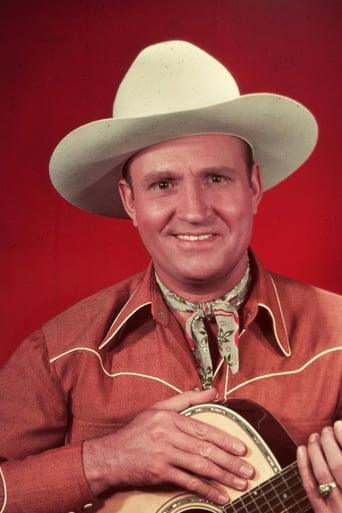Cathardincu
Surprisingly incoherent and boring
Protraph
Lack of good storyline.
Afouotos
Although it has its amusing moments, in eneral the plot does not convince.
RipDelight
This is a tender, generous movie that likes its characters and presents them as real people, full of flaws and strengths.
JohnHowardReid
Copyright 10 August 1942 by Republic Pictures Corp. No New York opening. U.S. release: 17 August 1942. U.K. release through British Lion. Australian release through British Empire Films: 8 April 1943. 7 reels. 6,700 feet. 74 minutes.SYNOPSIS: Packing company agent attempts to defraud ranchers.NOTES: 55th of Autry's 93 movies.COMMENT: A crooked packing company employee tries to swindle ranchers in order to make good his gambling debts. The president of the packing company arrives on the scene to hear a ranch-type radio program and tries to assist ranchers who are unaware of his true identity. So far as action is concerned, this plot outline sounds none too promising. But, aside from the songs — and two of these are in immediate proximity to the credits — the movie is pretty much action all the way. Two splendid chases (one after a runaway buckboard, the other after a runaway train) are both filmed with considerable impact, thanks to running inserts and thrilling stunt-work. True, the excitement of the first is somewhat undermined by dull process inserts of the studio players, but I'm afraid this is standard Hollywood practice, even for "A" features. All this action puts Burnette in the shade too. Except in the opening sequences, he has little of his usual foolery.Autry is at his charismatic best, Ruth Terry makes a vivacious heroine, Thurston Hall has a characteristic role, and it's nice to see Marc Lawrence as the villain's chief henchman. Production values seem lavish. I couldn't spot any stock footage, yet the locations are attractive, complete with lots of cattle and extra players. The featured cast is extensive too, whilst frequent changes of scene add to the agreeably fast pace. In all, Republic have given this one really loving treatment.The Sons of the Pioneers provide backing for Autry's near-credit- title songs. As in Starrett's westerns, they are ostensibly employed as the hero's cowpunchers, but they figure much less in the action here, though they do spend a fair amount of time hovering around in the background.
krorie
The year 1942 was Gene's last year as the number one cowboy in American, a rank he had held for almost a decade. When he went away to war, Roy Rogers became the King of the Cowboys. Though Gene was able to regain some of his popularity, especially on early television, he was never again number one. "Call of the Canyon" was one of his last movies before he left the screen to serve as a flier with the Air Transport command during World War II. Also by 1942 music was beginning to play a larger role in his films. The grand finale of "Call of the Canyon" is more like a Hollywood musical extravaganza than the end of a western where the cowboy rides off into the sunset. Unlike fellow singing cowboy Roy Rogers, Gene put as much effort into his recordings as his movies and sold millions. So music was always a key element in his life. His sidekick and lifelong pal, Smiley Burnette, was also into music and wrote over 400 songs, such as "Lazy Day" and "Ridin' Down The Canyon." Even with the music, there is still plenty of action. It seems a representative of the chief cattle buyer is shortchanging the cattlemen, headed by Gene, to pay off his gambling debts. The chief cattle buyer, Grantley B. Johnson (Thurston Hall) goes incognito as a cattleman to find out why the ranchers are so disgruntled with his prices. This leads to lots of action in trying to drive the cattle to market for a fair price. When the representative Thomas McCoy (Edmund MacDonald) uses explosives to stop the drive, one of the cattlemen is killed. The film has a subplot about a local band trying to make it big on the radio. The lead singer is known as Kit Carson (Ruth Terry) and becomes unhappy when Gene gets more of the spotlight than she does. Gene Autry westerns usually took place in the modern west, so airplanes and other motor vehicles are usually seen. In "Call of the Canyon," radio is used to catch the bad guys.Smiley is around for laughs. This time he has a young sidekick who had appeared with him in earlier films, Tadpole Millhouse (Joe Strauch Jr.). Tadpole looks, acts, and talks like Frog, who is not really his father because Frog is supposed to be single, but more like a father figure to the little tad. When the little tad is injured in the explosion Frog sits up with him at the hospital. So the viewer knows that the two are as close as father and son.The legendary Sons of the Pioneers are around to help with the music. They were at the top of their form in 1942 and add much to the musical numbers in the film. One of their founding members, Leonard Slye, was no longer with them for now he was Roy Rogers, a friendly rival to Gene and his gang.If you're a Gene Autry fan, get ready for action and music. You're sure to enjoy "Call of the Canyon."




